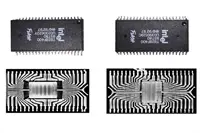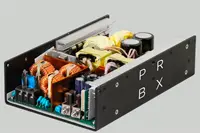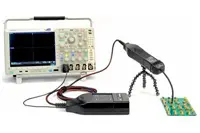Electronics News
Archive : 23 March 2016 год
 ESCO’s latest anti-counterfeiting forum highlighted some of the problems facing those procuring hard to get components.
ESCO’s latest anti-counterfeiting forum highlighted some of the problems facing those procuring hard to get components.
Gary Moffat, UK sales manager for Retronix, said: “It’s not always possible to wait for 24 weeks for a device and there’s pressure on purchasers to get products to customers.”
While not all suppliers in the so called ‘grey’ market are handling counterfeit parts, purchasers are advised to pay more attention to who they buy from. “If we can’t stop counterfeits at source,” Moffat noted, “we must have the correct strategies in place to ensure parts are stopped before they enter the supply chain.”
Peter Marston, consultant with end of life semiconductor specialist Rochester Electronics, noted a new wave of obsolescence challenges and, potentially, counterfeit parts. “Rochester has already had to buy a packaging factory because suppliers are pulling out,” he said. “One of the first packages to be affected is the 40pin DIL in ceramic and plastic, but there is also pressure on 240pin PQFPs. The issue with ceramic packages is persuading manufacturers to continue making piece parts.”
He also sees current moves to develop anticounterfeiting standards as a potential problem. “Counterfeiters are now seeing these standards as targets to be met,” he warned. “Customers must help themselves by procuring safely.”
Pic: An authentic flash memory IC and its counterfeit replica. Although the packaging of these ICs are the same, the x-ray images reveals that the inside structure of the counterfeit one (on the left) is different
Author
Graham Pitcher
Source: www.newelectronics.co.uk
 A series of power supplies for medical applications BF (Body Floating) has been announced by Powerbox. Complying with IEC 60601-1-2: 2014 (4th edition), the seven devices in the OBS01 series deliver 1100W, but can support peak demands of 1250W.
A series of power supplies for medical applications BF (Body Floating) has been announced by Powerbox. Complying with IEC 60601-1-2: 2014 (4th edition), the seven devices in the OBS01 series deliver 1100W, but can support peak demands of 1250W.
Offering an efficiency of up to 89%, the devices are said to meet conducted and radiated EN55011 class B requirements without the need for additional components.
Devices in the OBS01 range can withstand 4000V AC from input to output, providing 2 x MOPP (means of patient protection), 1500V AC from input to ground (1 x MOPP) and 1500V AC from output to ground (1 x MOPP). Earth leakage current is said to be lower than 300µA.
The seven devices in the series offer: 24V/45.84A (peak 52.10); 28V/39.29A (44.65A); 32V/34.38A (39.07A); 34V/32.35A (36.77A); 36V/30.56A (34.73A); 42V/26.20A (29.77A) and 48V/22.92A (26.10A).
“The OBS01 range is the result of two years of R&D and technical innovations bringing to our customers a power supply which has the highest power density on the market, the lowest EMI, while keeping the leakage current below 300 µA, which requires state of the art technology,” said Martin Fredmark, vp of product management. “The OBS01 guarantees the best performances to power demanding medical applications, working fully coherently within complex radio environments.”
Author
Graham Pitcher
Source: www.newelectronics.co.uk
 Tektronix has unveiled its IsoVu technology at APEC 2016, the technology is claimed to offer complete galvanic isolation between a device under test (DUT) and an oscilloscope through the use of electro-optical sensors. Tektronix says it will be the industry’s first measurement solution capable of accurately resolving high bandwidth differential signals in the presence of large common mode voltage. The technology will also offer immunity to external interference and radiated emissions, minimising the impact of EMI on measurements.
Tektronix has unveiled its IsoVu technology at APEC 2016, the technology is claimed to offer complete galvanic isolation between a device under test (DUT) and an oscilloscope through the use of electro-optical sensors. Tektronix says it will be the industry’s first measurement solution capable of accurately resolving high bandwidth differential signals in the presence of large common mode voltage. The technology will also offer immunity to external interference and radiated emissions, minimising the impact of EMI on measurements.
To date, design engineers working on power device designs involving GaN and SiC technologies and other high-speed applications have had no way to accurately visualise differential signals when common mode interference is present. As a result, these signals are essentially hidden, making it difficult for engineers to see what is actually occurring inside circuits, slowing debug and characterisation efforts. Engineers also face challenges making measurements in noisy environments or those that have high EMI.
The IsoVu technology is claimed to have the potential to resolve these challenges. It utilises an electro-optic sensor to convert the input signal to optical modulation, which electrically isolates the DUT from the oscilloscope. IsoVu will incorporate four separate lasers, an optical sensor, five optical fibres, and sophisticated feedback and control techniques. The sensor head, which connects to the test point, has complete electrical isolation and is powered over one of the optical fibres.
Earl Thompson, senior vice president, Time Domain Business Unit, Tektronix, said: “An electrical connection between the oscilloscope and the DUT impacts measurement results. By moving to an optical connection, this technology has the potential to eliminate that as a problem and as a result could advance the state-of-the-art in power measurement and EMI test systems.”
IsoVu technology is claimed to offer greater than 120dB common mode rejection from DC to 100MHz which is said to be 33,000 times better than previously available measurement systems.At 1GHz, Tektronix says, it will provide 80dB common mode rejection at 1GHz, which is more than a thousand times better than previously available measurement systems. As a result, users will be able to measure anywhere in their circuit without common mode interference.
Using this technology, engineers will be able to accurately measure differential signals between 5mV and 50V in the presence of large common mode voltages less than 2kV from DC to 1GHz. This is also claimed to be the first signal acquisition product where the common mode voltage capability does not de-rate over bandwidth.
Additionally, Tektronix plans to offer a 10m fibre optic cable option to allow users to move their test system away from the interference and radiated emissions of the DUT. As such, it will be suited for remote testing and EMI validation applications.
Author
Tom Austin-Morgan
Source: www.newelectronics.co.uk

